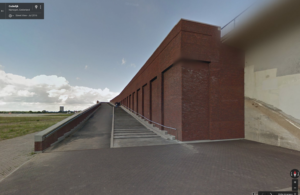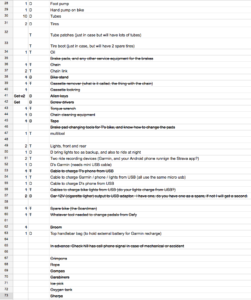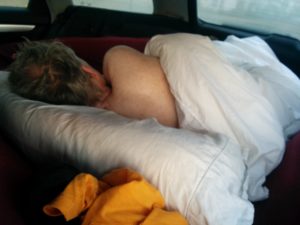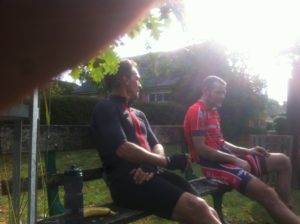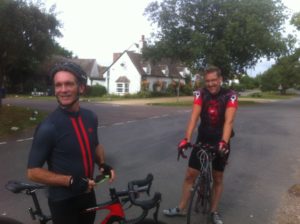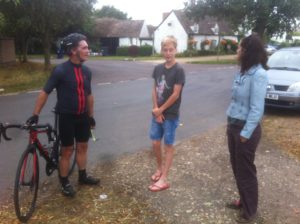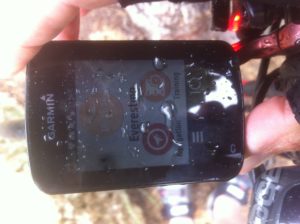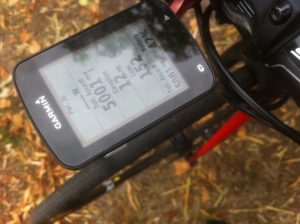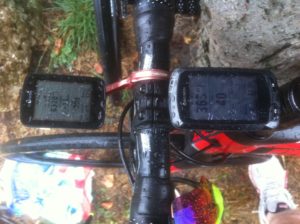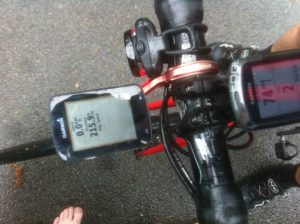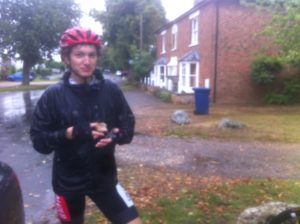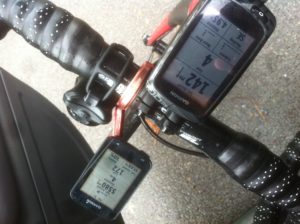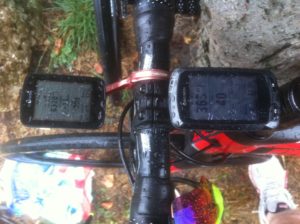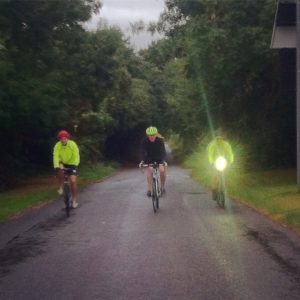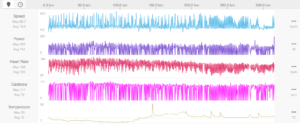Yesterday (Sept 3, 2016) I did an Everesting ride on my bike. As a concept, Everesting is dead simple. You pick a hill, any hill, and ride up it enough times to equal or exceed the vertical height gain of mount Everest (8,848 meters). Here are the rules. There’s a Strava blog post, The Ultimate Climbing Challenge: Everesting, that gives a good overview and some history.
I’d read a bunch of other people’s blogs about Everesting and found them helpful, so I’m hoping my own write up will help others. Also I know that if I write it all down I’ll come back and read it over the years, be happy I took the time to do it, and that I’ll forget almost all the details if I don’t. I decided to be selfish and write for myself, so if you’re looking for Everesting advice you’ll have to bear with the prose. But that’s ok, because if you can’t handle reading a long web page you might not be able to handle an Everesting anyway :-)
There are lots of Strava links below that you wont be able to follow unless you have (or create) an account, sorry.
Cast of characters
- Derek Smith – my partner in crime, who organized things, brought a ton of supplies, drove us out there, stayed the whole time, and rode about 20 ascents on a bike with highly unsuitable gearing.
- James Barlow – a St Ives CC cyclist who started the attempt but had shoulder and neck problems half way through. James is a much better, much stronger, and much faster cyclist than I am.
- David Pattinson – my office mate, who swooped in unannounced to ride the last 20% with me.
- Beth Evans – just graduated Cambridge and has been working with us over the summer. A British Military Fitness enthusiast. Don’t mess with Beth.
- Jeremy OneLung – St Neots based cyclist who probably holds the record for most number of guided busway rides.
- Ana, Lucas, and Findus – my wife and our two youngest kids.
Before anything else, THANKS to everyone. Though I perhaps could have done it without you, I really don’t think I would have. I’d have been too wet and cold and miserable to go on. It ended as a team effort, as you’ll see.
10% of an Everesting
I think David first told me about Everesting, and we said how silly and extreme it sounded, and of course said many times that we’d like to do it.
I’ve been doing quite a lot of cycling training this year, including trying to get stronger on hills. Unfortunately there really are no hills around here (in Cambridgeshire). But there are some climbs that are still challenging if you’re not much of a climber (like me) and you try to do them in a difficult way (e.g., in a very high gear, or standing up on the pedals, etc). I’d been happy to feel myself getting stronger on hills and to reach the point where I was able to stand on the pedals climbing for about 4 minutes.
I was in Holland a few weeks ago, cycling with two of my kids. We had a rest day in Nijmegen, where there are some small and a bit steep hills rising from the river into the city. I decided to go back to a ramp I’d ridden up with the kids and do some tiny intervals on it. Later, Derek took some screen shots from Google street view, one from the bottom, one at the top looking back towards the city:
I took my son’s bike, which is my old Boardman Hybrid Pro. Real road cyclists would turn up their noses at it, but it’s a damned good bike, not much different from a road bike (just the handlebars and a little heavier). I did a few ascents, standing up and in a pretty high gear to make it hard on my legs. After 10 ascents or so, I started to think about how many I should do. The ramp is only about 100m long and according to my Garmin had about a 9m altitude gain. So it’s something like a 9% average incline. I decided I could probably manage 100 ascents, and that’s what I did. I did the laps all standing up, though I did click down to a slightly easier gear. People looked at me as though I was a bit odd, and asked questions in Dutch.
At the end I wasn’t tired. Or maybe I was, because I titled the ride “1% of an Everesting”. I thought it wasn’t so bad, and that maybe, just maybe, I could do that 100 times. Derek then pointed out that it was actually 10% of an Everesting! At that point I thought wow, on the right hill and with my road bike, I could definitely do an Everesting. The 10% took 1.5 hours, so maybe 15 hours for the full thing.
My Garmin (or GPS) went nuts on the ride – a recurring theme, as you’ll see – and showed that I’d made a quick side trip to somewhere hundreds of kilometers away, at an average speed of about 200km/h. So I reluctantly deleted the ride and added a manual entry instead. James made a comment, asking if I wanted to do “something silly” – a full Everesting, and I said yes. Jeremy suggested I edit the original Garmin file to crop out the spurious extra hundreds of kilometers. I used Fit File Tools to do that and it worked out perfectly.
At that point, an Everesting attempt with James was on. We just had to find a hill and pick a date.
Finding a hill
I wanted to do the Everesting in Cambridgeshire, because that’s where we live and there hadn’t been an Everesting done here – perhaps because there are almost no hills, and certainly no big ones.
James suggested either the weekend of 27/28 of August or the weekend of 3/4 September. I mailed Derek and David, who both replied that they’d be out of town the first of those options but back on the 3rd/4th. Derek said he’d do all the logistics and ride a bit, and David said he might join and would at least come along for part of it.
James suggested we use The Heydon Mountain Top Ascent of Gran Canaria. It’s a 2.2km segment and you gain 80m. It sounded good at first. But the Everesting Cycling Calculator said we’d have to do 107 laps to gain the required altitude, a ride of 480km! James has cycled nearly 17,000km already this year, and can do that, as he’s proven repeatedly. But could I handle nearly 500km in a day, with most of the time spent going uphill? I doubted it. Derek and I did a recon ride to check it out. Apart from finding the segment too long, the road was a bit rough and it felt to me like there would be too much thinking involved. I’d read multiple blog posts about people going to “a dark place” and hallucinating after 7,000m of climbing. I didn’t want to be doing any thinking by that point, and the segment had some curves you can’t see around, a high-speed curve in the descent, an awkward corner at the bottom turnaround point, and seemed a bit too populated at the top.
I told James I’d do it but that I wanted to keep looking to see if there was a better and shorter option. That therefore meant something steeper. But where? Velo Richard has written a couple of blog posts, The ahem Big Cambridgeshire Climbs and The Short and Steep Cambridgeshire Climbs which should give you some idea of the “hills” in this part of the world. I picked out two possibilities, very close to each other.
The first was the Barham climb, in which you gain 13m over 200m, requiring 707(!) laps, but needing a total ride distance of only 300km. I went out and rode it and didn’t like it one bit. It’s a tough little climb, probably over 10%, on a rough surface, with no visibility at the top for oncoming traffic.
The second possibility was Staunch Hill. I went and rode it half a dozen times and found it almost perfect. It would be 247 laps, for a total of 280km riding. That was definitely in my distance range, though I didn’t know if I could handle that much hill climbing.
20% of an Everesting on Staunch Hill
So I went out a few days later and did 20% of an Everesting on Staunch Hill. I did it party in daylight, partly in the dark. It was great, really great, and I knew we had our hill. Or at least I knew I had my hill, and was hoping James would be happy with it too. And he was. It took me almost exactly 3 hours to do the 20%, which was right on line with the 10% in 1.5 hours in Nijmegen.
What made Staunch Hill perfect? It’s dead straight. Although you can get to it from the A14 highway, you can only do that from one direction and the road only leads to a tiny quiet village, Leighton Bromswold (population about 200). The surface was smooth and there were no potholes at all, just a couple of very minor bumps that you could easily ride over with no problem. The road was wide enough for 2 cars to pass. At the top there was a spacious and open T intersection with essentially zero traffic. And a nice-looking pub, The Green Man (first licensed in 1650), which I told myself it would be great to eat in and have a final beer in, even though I doubted I’d actually do that. At the bottom there was tons of visibility in both directions. The bottom was a little narrow, but not so narrow you needed to unclip. In the 3 hours I was riding I was only passed by about 10 cars, all driving carefully and not at high speeds.
It also seemed perfect in terms of what I needed to do to get up it. My bike has a compact (50/34 teeth) chainring on the front, and Derek and I had (eventually) put an 11×32 cassette on the back when I was getting ready to do a ride in the Peak District. I have a Stages power meter which, as a not-very-experienced cyclist, I find incredibly useful. I’ve been using it for maybe 6 months now, and I have a pretty good idea of what power levels I can attain and (more importantly) sustain. I rode Staunch Hill very carefully, watching the power meter the whole way. I found that if I was on the small ring (34 teeth) and the 32 tooth rear cog, and kept the ascent as gentle and easy as possible, that I could keep peak power down to 280 watts. My Functional Threshold Power is about 250W (i.e., I can in theory sustain 250W for an hour). I figured I could handle pushing up to 280W briefly over and over again, as long as I got a rest in between. BTW, 250W is not very much – it’s probably what you use in one leg just climbing stairs. If you’ve ever gotten up on your feet out of your saddle to go up any incline on a bike, you’ll likely have exceeded 280W.
I also know a lot about my heart rate, again from doing lots of training. On Staunch Hill I was peaking at about 155bpm, well below what I can sustain for an hour (about 170bpm).
So I was fairly confident that if I just made sure to ride slowly and at those power and heart numbers that I could probably go on for a long time.
Back to the story… we now had a date and a hill and 2 weeks to wait.
I did a 113km ride the day after the 20% ride, and then the 203km Mildenhall audax the next weekend. In the week before the Everesting I took it very easy, just cycling into Cambridge and back once (under 40km in total).
The spreadsheet
It would be wrong to leave Derek’s spreadsheet out of the story.
He made a spreadsheet on Google docs and shared it with David and me. I took a look and wanted to run! It seemed so over the top, with 60 rows of stuff. Included were 10 spare tubes, 2 spare tires, an extra bicycle, a bike maintenance stand, and many other things, some with eye-popping quantities. I couldn’t handle it, and decided to politely ignore the spreadsheet entirely. David took a different approach and added items Derek had forgotten: crimpons, rope, compass, carabiners, ice pick, oxygen tank, and sherpa.
As we got closer to the day, I thought better of my silence and discretely applied strikeout to about half the items on the sheet and replaced some of the quantities by their log base 10. We still had enough equipment and supplies on the day to support a small team of Everesters.
Here’s a screenshot of just the lower part of the Everesting spreadsheet (click to see the details):
To be completely fair, I added (and then crossed out) the broom, which I thought we might use to clear loose gravel or stones from the sides of the road in the narrow turnaround area.
Linear scaling?
Although I was feeling pretty confident, there was an unknown lurking right at the heart of all pre-Everesting discussions, thought, and planning. How would things scale for me over time? I.e., was it safe to assume that the last 80% of the ride would be just like the 20% that I had actually done? Or would things go non-linear? I’d read many blog posts talking about hitting the wall at about 7,000m, etc. Derek and I could only guess at what might happen to me, we really didn’t know. So of course we had to be on the safe side. I’d done the 200km ride in 6 hours 45 mins, on just a piece of cake, a sandwich, a candy bar, a coffee, and several bottles of water. It was obviously not safe to just double those numbers and hope for the best. And what about my heart rate over the ride? Would I have cardiac creep, in which your heart rate goes up even though the power you needed to input stays flat? If so, I would be in trouble because it hadn’t been possible to get up the hill in my lowest gear at less than a 280W peak. What about my body – my knees, my neck and back, my muscles, other joints? I just didn’t know what would happen, and wished this wasn’t my first Everesting.
100% of an Everesting
Derek volunteered to drive me out there, with both our bikes in the back of his car. He said he’d stay through the whole thing. I thought that was unnecessary and asked him what he planned to do that whole time, especially sitting there alone in his car at the top of the hill for many hours in the dark. He told me he was planning to monitor my nutrition – carbohydrate, protein, liquid consumption, etc. I wondered how he was planning to do that, and told him that I felt like some kind of laboratory animal in an experiment. Anyway, I was very glad for the company. If blogs about Everesting agree on any one thing, it’s the need for good support, and I definitely had it.
We’d arranged to meet James at the top of Staunch Hill at 1am on Sept 3, 2016. He’d suggested the night before that maybe we could meet at 8pm to avoid the predicted rain in the afternoon of the 3rd, but I wouldn’t have been able to sleep before the ride. It didn’t make sense to me to do an Everesting without sleeping beforehand! But James is good at finding ways to make rides more extreme, like adding 225km round trip to get to & from a 175km sportive, and probably didn’t think that was a big deal. When I told him I’d like to sleep, he said yes, that I could do plenty of sleeping after the Everesting. I told him to go for it if he wanted, but that I much preferred the sleep plus rain combination (which is exactly what I got). In the end we settled on a 1am start. Derek and I drove out there, while James did a little 27km warm up ride from St Ives, including 300m of pre-Everesting climbing.
We arrived about 15 minutes ahead of James and I changed into my gear and got ready. I asked Derek if he was going to ride some laps with me, and he said he thought he’d better not because he’d have to use a light and it would be better to keep his light in reserve for me. That turned out to be code for “I’m about to have a 7 hour sleep in the back of my car.”
I did a few laps and then James arrived. He said he was almost ready to begin, but needed a cigarette first. I’m not making this up. Derek suggested that the Hell’s 500 people who maintain the Hall of Fame could add an asterisk next to his name as someone who smoked during the Everesting. I hate to think what his cycling would be like if he didn’t smoke! It subsequently occurred to me that perhaps James doesn’t actually smoke! That maybe he turns up at ultra distance events, and while everyone else is stretching, slamming last-minute gels and organic carb and ethically-sourced protein bars and nervously eyeing other cyclists, James says “Hang on a minute guys, I need a final smoke.” At that point the event may as well be over. Stephen Potter, who wrote a classic little text on gamesmanship that I read when I was about 14, would have been deeply impressed.
Turn off your mind, relax and float downstream
I got into a rhythm, doing each lap in almost exactly the same way. Descend completely relaxed, with no pedaling but stretching my legs a bit. Brake and turn at the bottom after looking over my right shoulder for cars. Keep the first (quite flat) part of the ascent at under 200W. Begin changing to lower gears at the sign on the right. Be in the 28 tooth cog just after the dark patch on the road. Be in the 32 tooth just after the strip of lighter-colored concrete a bit later. Ride up as gently as possible, eyes on the power meter. Keep it under 280W when it got steepest. Breathe properly. Relax. Hands loose on the handlebars. Stand up on the pedals on the flat at the top and stretch both legs. Push the lap button on the Garmin at the same place at the top every single time. Stand up and do a few seconds of mini sprint on the flat heading back towards the descent. Change down 4 gears so I wouldn’t have to change at the bottom. Repeat. That was basically it for 16 hours of riding.
A few songs went round and round in my head. In particular, The 801‘s beautiful 1976 cover of Tomorrow Never Knows (which I somehow didn’t even realize was a cover, even though I had heard the Beatles version many times). Lyrics.
Turn off your mind, relax and float downstream
It is not dying, it is not dying.Lay down all thoughts, surrender to the void
It is shining, it is shining.
I’d sing the first lines to myself on every descent, telling myself to take the opportunity to switch off my mind, to completely relax, and to enjoy whizzing down the hill in the dark at 60km/h.
Pretty idyllic. What could possibly go wrong? I’d mentioned to James that one possibility was that a rabbit or fox might run out on the road in front of us. I hadn’t thought about badgers though. I saw two of them. One crossed the road running diagonally across and away from me. The second, which was larger, went straight across in front of me at a distance of about 10m. At 60km/h you cover 10 meters in 0.6 seconds. Human reaction time is about 0.5 seconds, so at that kind of distance you basically have no time to do anything. I’d never seen a badger in the wild, at least not alive, and didn’t realize how large they are. If you hit one on a bike at that speed you’d go flying, for sure. Fortunately, nothing else sprung out of the thick bushes and trees on either side of the road, apart from a rabbit or two.
I had resolved to ignore James, apart from not colliding with him when we crossed. I didn’t want to try to match his speed, because I wanted to do the ascents as slowly as I could. At the start I found myself going over 300W sometimes (very easy to do when you’re aiming for 280W) as I watched him ahead of me. He was standing up on the pedals on parts of all his ascents, and generally being James. He was doing laps 10% faster than I was for the first hours. He’d also done 300m more climbing on his way to the start, so our total ascent numbers were off.
After a while I just told myself to watch the power meter for the whole of the ascent. I knew I’d managed to block everything else out when I saw James at some point and thought to myself (half joking, but with a smidgin of truth) “Hell, there’s that same cyclist again. Who is that guy?”
At about 10% into the ride I remember thinking that it felt like I’d done nothing, and thinking “and that’s exactly how it should feel. Good.”
Eventually it began to slowly get light. That gave me an opportunity to snap a photo of Derek in his car “monitoring my nutrition” and “saving his light for me in case I needed it”. Here he is, at 6:40am:
By then, James and I had been riding for 5.5 hours. We’d stopped several times for short breaks (of I guess 5-10 minutes) to eat. We’d open the car and talk to one another, and Derek would sleep right through it. Probably a good thing, as he’d driven to Liverpool and back that day and was going to need his energy.
If you’re curious, I was wearing a Stolen Goat Orkaan Race Tech Weatherproof SS Jersey and their arm warmers. The Stolen Goat jersey is a tech marvel. See this review and watch this video. The first time I rode in the top I was out riding fast (and hence sweating) for 3.5 hours in the rain and it was bone dry inside. There’s a trade-off with the best modern cycling tops – they’re not completely waterproof, in exchange for fantastic breathability, and you still get warmth. I rode in that top and arm warmers all last winter, in the rain (often) and snow (occasional). I also have the waterproof cap shown in the video, and had it in my bag. Amazingly, Stolen Goat is a one-person company, run by Tim Bland.
James was better prepared, as he also had a gilet on. Although the temperature was fine, what I hadn’t taken into account was that the descents were cold. Even though the temperature was 12C at its coldest, going through that at 60km/h is chilly. So I was a little cold. After a few hours I swapped my socks for a warmer pair, the DeFeet Woolie Boolie (currently 1/2 price). It probably seems silly to read about cycling socks if you’re not a cyclist living in a relatively cold country, cycling through the winter, but socks are important. Suffice to say that the Woolie Boolie are fantastic – thick, warm, and breathable.
Garmin’s poor altitude attitude
I had my Garmin set up to show 3-second power average, total elevation gained, heart rate, and lap count. There were plenty of other things I could have displayed (in particular, cadence and time), but I knew what my cadence would be if I kept to my power aim, and I didn’t care about the time. I’d press the lap button at the top of each ascent, and would look at the lap times (typically 3 mins, 30-40 seconds).
Everest is 8,848m and I wanted to see (and photograph) my Garmin go through that total. It seemed a hell of a long way off, but I knew that once I was half way it would start feeling really close and that I just had to keep going. So I was most interested in the total ascent number.
But there was a problem, or a potential problem. I was surprised to note that my lap count multiplied by 36m was higher than the figure the Garmin was showing. I changed the Garmin to show the current elevation and started watching the altitude at the bottom and top of the hill. I was alarmed to see that I was getting about 31m of ascent credited on each lap, and sometimes as low as 29m! Holy shit, I was being ripped off about 15% of my elevation gain by the crappy Garmin barometric pressure sensor and/or calculation. Was I going to have to ride 15% more (over 10,000m) to get the displayed total ascent up to 8,848m?
After a while I found that if I spent a few extra seconds at the top and bottom of each lap that the Garmin would catch up and credit me with the full 36m. So, supposing I added 10 seconds to each lap, that would be 2,500 seconds (41 mins) of time waiting, which was much less time than it would take me to ride an extra 1,300 vertical meters, so I slowed it down.
100 laps in
Our target was 247 laps (though I mainly wanted to hit the altitude number, as well as the lap count). At about 100 laps we were about 40% done. At around that time I found Derek looking fresh, stretching, and smiling on the side of the road at the top of the hill. With his electric toothbrush.
At 1am just before starting, Derek had asked me if I’d checked my tire pressure. I wanted to get started, so I said “yes” and didn’t finish the sentence, which would have ended with “about a week ago”. I’d actually only given them a quick squeeze and thought “she’ll be right.” Near the end of the 100 laps, it was obvious that the rear tire was going to need some air. Looking down and back, and comparing it to the front tire, I could see it was a bit flat. I asked Derek if he could put a bit of air in it and to tell me what its pressure had been. 50 lb per square inch! That’s about half of what I usually put in. He asked if he should also put some in the front and I said I thought it was fine. He did it anyway, and reported that it had been at 60! What a novice error. I’d done 100 laps with greatly under-inflated tires. The ride was nice and smooth, though.
If you’re curious, the received wisdom (narrow, hard) on bike tires is now being repeatedly challenged in carefully conducted experiments on rolling resistance. It’s no coincidence that I was running 28mm Continental Grand Prix 4 Seasons tires.
With the tires both at 100 lbs psi, I found I could get up the hill at 10W less than before. A belated discovery, but nice.
A little before stopping at 100 laps, I’d heard James make a noise as I began the descent and he was just getting to the top of the steepest part of the climb. I wondered what it was and if he’d been trying to say something. A couple of seconds later I realized it had been a grunt of pain. I figured it couldn’t possibly be his legs, but didn’t think too much about it. When we stopped he told me his shoulder and neck were bothering him. He didn’t sound too worried, but I thought that sounded bad, given that we had to keep climbing for at least another 9 hours and that I figured James wasn’t the type to complain, given the kind of punishment levels he’s clearly able to deal with.
Here we are, at about that time, having a break on a bench, with a bit of Derek’s finger thrown in for good measure:
At about 4,000m James told me his wife and kids were arriving and soon after I saw them sitting together at the top. I stopped to say hi and James said he was done. He’d done a 500km ride into stormy weather and a strong headwind a couple of weeks ago, and had ridden several hundred km already last week before the Everesting. I asked him about his gearing. He had a 54/39 elliptical chainring, but said the small ring is actually like a 42 tooth at its widest! And on the back, an 11-28. So his gearing was much tougher than mine. I seriously doubt I could have gotten up the hill more than a few times on his bike. I wondered if it would even be possible for someone like me to ride that bike up that hill without having to stand up on the pedals.
Cue Jeremy
At about 10am, a cyclist with a friendly face had appeared on my left as I reached the top. I knew immediately who it must be, even though we’ve only cycled together once and I couldn’t remember his face. You’re more likely to remember another cyclist’s legs or bike. Only one other cyclist (apart from people I know well and who had declined to join) knew we were making the attempt, and indeed it was Jeremy. He’d been reading and commenting along to the 60+ messages James and I had exchanged in planning the attempt.
Jeremy had obviously chosen his outfit and bike with care. I thought we made a fetching, well-matched team:
The only thing missing was some “Team Mamil” branding for our jerseys.
Unfortunately, his gearing left something to be desired! He had an 11-21 cassette, and given that I don’t think it really mattered whether he had a compact chainring or not (I should think not). He rode a few laps with me, and how he managed to get up the hill I cannot say (I suspected mechanical doping, but was too polite to bring it up). Half way up one ascent I told him that turning up to an Everesting with an 11-21 cassette was like bringing a knife to a pistol fight. I think his reply was mainly a grunt.
Jeremy did a 55+km round trip to come see two guys, one of which he’d only met once before and one he’d never met. How nice is that? Here are his rides, out and back (note the photos), showing his Staunch Hill climbs at the end and start respectively. Jeremy hung out at the top with Derek, and then with James, for an hour and was generally full of good cheer and self-deprecating humor.
Rain!
With James out and Jeremy gone, Derek and I were left alone and I was sitting on about 4,000m. Before he left, James gave me an update on the weather forecast – that rain was coming, as we’d known, but that it was looking ok and should only rain for an hour or so. The first few drops were falling around the time he left.
And rain it did. It was never absolutely pouring, but there was quite a lot of it. Enough to drench me. Hard enough to painfully sting my forehead coming out of the tree cover at 50 or 60km/h on the downhill. Enough to absolutely soak my socks and weatherproof (not waterproof, see above) jacket.
I told myself to just enjoy the rain, not to think of it as a bad thing, that it’s just water, and that many other people had been through much, much worse. It was quite warm, but not so much on the descents in the wind.
And for some added Everesting-in-the-rain cheer, I suggest the theme song from Rawhide
Rollin’, rollin’, rollin’
Though the streams are swollen
Keep them doggies rollin’, rawhideThrough rain an’ wind an’ weather
Hellbent for leather
Wishin’ my gal was by my sideAll the things I’m missin’
Good vittles, love an’ kissin’
Are waitin’ at the end of my ride
performed unforgettably in The Blues Brothers:
After a while I decided to abandon the wet jacket. I dried myself with a towel (Derek thought of everything), and put on a cotton t-shirt and a pretty ineffectual Altura rain jacket that is actually Ana’s (I didn’t think of everything). I knew the t-shirt would soon be soaked, but at least for now I had something dry on. Like an idiot, I had looked at my fantastic fully waterproof Showers Pass jacket that morning, and decided it would be overkill. So I’m out there drenched and about to be re-drenched, and my fine jacket is back at home, dry as a bone, hanging on a hook inside the back door. And probably feeling confused and rejected.
I just ignored it and kept on. I had put my Stolen Goat waterproof cap in my backpack though, and I happily put that on. A warm and dry head, at least.
At maybe 2pm, Derek told me that the weather forecast had changed for the worst. It was now due to rain until 11pm! We estimated that I might be finished at about 9:30pm. The rest of the ride was going to be wet.
Derek’s car battery
Derek drove me to the Tour Of Cambridgeshire race back in June (here’s my ride, which was a total blast). While the race was on, he was in his car and managed to run its battery down. After the race I returned to find the car gone, and cycled around a bit to find him and hear what had happened. Fortunately he’d had his bike with him too, and had been going to ride to a garage to buy some jumper leads, before he happened to meet someone at the race who had some.
So I thought he was kidding when he told me at 3pm or so that he’d run the car battery down and was going to go off on his bike to buy some jumper leads from a garage in Spaldwick. But it was true! He left me the car key so I could get in for food and headed off.
About 10 minutes later I see him heading back along the village road from the church, and he’s no longer alone.
Cue Beth
Beth Evans had told us during the week that she’d cycle to Leighton Bromswold to join in some of the Everesting. She’s a British Military Fitness enthusiast and recently cycled 1500km alone in Eastern europe on an old hybrid bicycle. I asked her if she knew the way, and she said “kind of” in a very untroubled way. I asked how she normally navigated on her bike. “Well, I just go in what I think is the right direction and when I get lost I look on my phone.” And that’s exactly what she did, or I guess tried to do, after finding part of the busway from Cambridge was closed for repairs and following her nose. She’d somehow converted the 50km ride from Cambridge into an 85km ride, in the rain, about which she seemed perfectly happy.
She was tired, and Derek was heading off to the garage, so we suggested she hop in the back of Derek’s car and have a sleep. Did I mention that he had a mattress, two pillows, and a nice-looking comforter in there? So Beth had a sleep and I cycled on.
Later, from the comfort and warmth of the back of the car, she extended just the tip of one finger from the window, and, with perfect deadpan, said “Oh! It’s raining out there.” My kind of humor, I thought, resisting the urge to strangle her.
Much later, with Derek and Beth both warm and dry in the car, I couldn’t resist (well, I didn’t actually try) singing some snippets of Don’t Stand So Close To Me to them:
Young teacher, the subject
Of schoolgirl fantasy
…
This girl is half his age
…
Sometimes it’s not so easy
To be the teacher’s pet
…
Temptation, frustration
So bad it makes him cry
Wet bus stop, she’s waiting
His car is warm and dry
…
It’s no use, he sees her
He starts to shake and cough
Just like the old man in
That book by Nabokov
and then leaving them with an explicit wish that they enjoy some awkward silences.
Ana, Lucas & Findus arrive
Ana arrived with our two boys. So by this time we had 5 people from our Cambridge research group assembled at Leighton Bromswold. Here I am with Ana and Lucas, and then eating a pork pie with Ana and Findus:
After Ana took the boys home she made herself a coffee. Then she thought I might like one and filled a thermos and came back. By that time it was raining and the coffee was very welcome. It’s about a 30 minute drive each way from where we live. So that’s nearly 2 hours of driving to come help twice.
More Garmin woes
At about 5,300m I was having a break and talking to Derek. I went to the bike to check the ascent total and was very surprised to see that my Garmin had returned to display its home screen!
It never shows that screen when you’re on a ride, only when you’re not on one. WTF? “It’s lost the ride” I told Derek. I’ve had so many Garmin crashes and lost so many rides or partial rides that I’ve gotten used to it, and even come to expect it. We looked in the ride history, and indeed the ride wasn’t listed. I tried riding a bit, hoping the screen would change to show the hopefully-still-in-progress ride, but it didn’t. We’d taken a picture of the screen at 5,001m, following the advice of the Hell’s 500 rules page:
Yes, that’s a Garmin 820. About which I should probably write a review.
How had this happened? I’m pretty sure it was the rain. A couple of times earlier in the ride I’d notice my Garmin screen changed. Twice it was on the screen that allows you to change what’s displayed in a data field (so I’d just press the Back button to revert to the original selection). Once I even saw the screen get changed due to a rain drop. The screen is too sensitive. I can activate the touch screen without actually touching it, and very often it mistakes a press for a swipe and does a micro scroll instead of taking you down into a sub-menu. Garmin will hopefully sort all that out with a firmware update. I tried to turn on the screen lock but Garmin have moved that functionality: on the 820 (as I now know) you press and hold the power button, which I would never have tried because on the 810 that turns the unit off.
It was obviously a pain to have the Garmin go on the blink, but not the end of the world. I knew I was at about 5,300m and 160 laps. So we attached Derek’s Garmin (810) to my stem and I set off with both of them, feeling like a pro.
Before starting the descent, I had what seemed like a risky idea. If I pushed the button to stop the ride, and if it happened to still be recording, it might ask me if I was sure (as it usually does) and I could then just hit the same button again to continue the ride. So I went under a tree to be out of the rain (dreading a spurious button press in the wrong place at the wrong time from a raindrop) and tried it. It worked!
But then, just a couple of laps later, another Garmin oddity. I swiped left or right to see another screen, and got this:
And now the unit seemed frozen. It didn’t respond to any screen swiping and when I pressed any button it gave a single beep but otherwise didn’t react. I decided to ignore it and go for a ride. We’d been spending so much time trying to make the damned thing work that I just wanted to get on with riding. Did I mention that I was wet and it was raining?
Then, maybe 10 minutes later, I noticed the Garmin come back to life. In the bottom area of the screen above, it had the beginning of a list of my lap times! So I guess it had been thinking that whole time, and that once it goes into that mode of calculating all that information you can’t interrupt it. I’d actually seen that happen once before, though on a much lower lap count, somehow getting onto that screen due to raindrops, I assume.
While the Garmin had been having its nap, I’d done a couple of laps, and now wasn’t sure if the presses on the lap button would have registered.
A niggling pain
At some point, maybe at about 180 laps, I began to notice occasional short sharp pains behind my left knee. I had no idea what it was, but I still had at least 7 hours of riding to get through. I knew I could make it, as long as I didn’t have a bike problem, an accident, or some kind of injury like James and his neck/shoulder. The knee pain wasn’t bad, but the fact that it was happening was. How would it develop? Would it get worse and worse and force me to abandon as so many others had in the blogs I’d read? Or could it be kept under control? I watched the power meter carefully and saw that it only happened when I got above 210W on the ascents.
So I slowed myself down further, and found that I could take things even easier than I’d thought, and get up the hill without going much over 250W. I’m pretty sure it helped that the wind was up, and helping me with the ascents. My laps were up to about 4 minutes now (up from 3:40), so by slowing down I was adding about 8% to how long it would take me to finish, or about 30 minutes to the 7 hours it would still have taken me to finish (I love doing mental arithmetic on the bike). That was a far better prospect than not finishing at all. On each ascent I’d have a bit of knee pain, and then a chance to stretch the leg at the top and on the descent. I dropped the power on the flat bit at the bottom as well.
It was going to be a long 7 hours though. It was still raining, I was going slowly, and with the knee pain I was wondering for the first time if I was going to make it.
Deus ex machina
Earlier in the day an old guy (anyone who looks older than me is automatically and definitively “old”) had ridden down Staunch Hill and turned around at the bottom. I was doing my gentle ascent as he drew up beside me on his way back up. I said hello, and he replied “This is one of those hills you just do simply because it’s there.” I said “yes, that’s exactly right” and resisted the urge to bring up my tenuous connection to George Mallory. And oh, sweet irony, the guy did a single ascent and breezily rode off to the right when he got back to the top.
So at about 4:30pm, with about 50 laps to go, I was not in the slightest bit impressed to see a flimsily clad young guy zooming down the hill on a bike as I pushed slowly upwards.
And then as he got closer, I realized….. it was DAVID! He had a happy face with a huge smile. He stopped, clapped me on the back, then turned right around and joined the climb.
It was a deus ex machina moment. The arrival of the young Apollo. A powerful boyish god appears in the rain clouds above you, and swoops down into the action to save the day. It’s true that I may have been partly delirious, but it felt miraculous to have him arrive at exactly that moment, also wet, after a 50km ride in the rain from Cambridge.
Whereas Jeremy had been ultra careful and respectful of my riding space at a time when I was quite fresh, David was in my face immediately at a time when I was quite tired. On every single ascent when I moved to the 32 tooth rear cog, I’d said out loud to myself “relax”. I never said that again on the rest of the ride. I think I only thought about my knee pain once in the next 5 hours. Ten minutes after joining, David swerved suddenly and nearly forced me off the side of the road into the bushes during a climb! He rode on the left as we ascended, and I was stuck in the middle having to think about cars, which I hadn’t done at all in the previous 15 hours. He talked non-stop during the ascents.
And it was great, all super super great. I was out of the low spot and back to feeling carefree, happy, and super confident.
And so we climbed, and turned, and climbed and turned. Which reminds me: Brian Eno’s beautiful song, Taking Tiger Mountain had also been playing in my head.
We climbed and we climbed
Oh how we climbed
Climb how we climbed
Over the stars, to top Tiger Mountain
Forcing the lines to the snow
The last I’d heard from David about the Everesting was when he couldn’t make August 27th and James and I had moved the date to the 3rd. David joked that he thought he might have to be out of town that weekend too. After that it hadn’t occurred to me that he might show up. But he and Derek had been talking, and agreed that a good time to appear would be at the end. I’m glad they didn’t tell me, because I’d never have had such a surprise and certainly would never have compared David to a young god :-)
On one of the climbs, I asked him how the climbing pace was for him. He said it was fine, but that it would have been better if he hadn’t given blood two days earlier. Blood is kind of important when cycling up hills for hours on end. So there’s David, doing a 100km round trip just to get to Staunch Hill, in the rain, after donating blood. He was also completely soaked, and had also left his good waterproof jacket at home.
Here he is:
At some point I realized that Derek was sitting in his car in a dry rain jacket (another crappy Altura, but DRY), so it seemed a good moment for a carjacking. He gave me his cycling top and the jacket, so I was dry again, at least for the moment. To my surprise, David said he’d take my soaking jacket and use it instead of the soaking skimpy top he had on. So he put on my wet jacket and declared himself “so much warmer”.
We made a fine pair.
David rode the last 50 laps with me, and we ended with a joint sprint up the final ascent and a big hug. Thanks!
The Garmin decides overall ascent isn’t that important
Soon after David joined, the overall ascent figure on the Garmin simply stopped updating. Great. I remembered it had been on 6,300m and when I looked some laps later the number hadn’t changed. I said something along the lines of “The Garmin never misses an opportunity to fuck you in the arse.”
And there it was, stuck on 6,300m. The other Garmin wasn’t doing too well either. After an encouraging start, where it had awarded me 140m for 4 laps (almost bang on the money), it too had decided that overall ascent wasn’t really worth recording, and had registered a total of just 363m after 40 laps.
My already low opinion of Garmin bike computers had reached new depths. I told Derek and David that disgruntled Garmin employees had probably programmed it to detect when you’re doing an Everesting and to screw with you.
Riding to the magic ascent number was now completely out of the question. We’d have to just do it on lap count. I thought the total laps needed was 257, but Derek checked online and it was only 247!
Just 20 to go.
Derek enters the fray
Derek has a Giant TCR, and it’s not exactly set up for hill climbing (at least not by a regular human) with an 11-25 cassette. He’s also not been riding much this year due to foot surgery. But he joined David and me, pushing himself up that hill over and over, doing much more work than we were. And loving it.
Beth joined us for some laps and then took this photo of the three of us reaching the top of the hill:
Eventually the rain stopped, though the road was still wet and there were puddles at the bottom. The sky took on a wonderful post-storm golden color, the air had that feel of being perfect for photographs, and then things went pink and purple and finally it got dark.
Finishing it
We counted down the final laps. It was totally dark, after 9pm. The rain had stopped. We climbed side-by-side and got to what I guessed was 247 laps. I thought I had missed one lap button press when Jeremy arrived, and I had missed 2 while the Garmin was doing its thing calculating all my lap split times (one of which I had reclaimed mid-lap). So I thought I was off by one or two presses. We decided to do 250 laps, end the ride, and upload it to Strava to see what it made of it.
We did a sprint up most of the final ascent. Probably that was a bit silly because I could have injured that leg properly, but it was ok. There were hugs at the top, and I heard Derek say “Great” about 10 times in a row.
I finally got the Garmin to load the ride, turned on Bluetooth, got it to load the ride again, and uploaded it. Shit! Strava gave it as only 7,000m! Was I going to have to get back on the bike and do another 1800m of climbing, another 3 hours (when fresh), another 50 laps? James had done half the ride and Strava gave him 5,000m and I’d done the whole thing and been given just 7,000m. How was that possible? But at least the lap count was right, 250 of the suckers. At that point I just had to assume Strava would be able to correct the elevation (as it does reliably) and that the Hell’s 500 folks would accept the ride based on the laps and the fact that the hill rises 36m. And so it proved.
The elapsed time on the ride was 20 hours 44 mins, with 16 hours 12 mins in motion. So I had about 4.5 hours off the bike to eat food, socialize, and wrestle with the Garmin. I’d thought I might be able to get done in less time (with 15 hours riding) and maybe 3-4 hours of breaks, but it turned out pretty close. The Everesting calculator had said I’d do 279km, but it turned out to be 315km, so I did an extra 36km over the 250 laps. That didn’t matter much, as it was probably all at the bottom on the flat where it would have been work to stop sooner.
Here’s the ride on Strava, with a screenshot of part of the Strava analysis page for good measure:
Dinner at 11pm
David rode the 50km back to Cambridge with about 5 partially-charged bike lights, despite being asked to stop on the way, come to dinner, and get a ride the rest of the way with Derek. Derek and I got back to the house in Over at 11pm to find the kitchen table set, with candles, wine, champagne, and a ton of food ready.
We ate and then listened to music. Findus asked me if I was ever going to do a ride like that again. I said no, and that there wasn’t really much point – to howls of laughter. They all told me they could have told me that in advance.
After dinner I sent mail to Andy at Hell’s 500 and submitted my ride. Today he replied to say it all looks great, and that I’m now listed in The Hall of Fame and on a special page at VeloViewer. Good.
The fine folk of Leighton Bromswold
We met probably a dozen people from Leighton Bromswold, which is a significant proportion of the total population. They were incredibly friendly, curious, supportive, and kind. Word got around about what we were doing. People pulled over in the cars to ask how it was going and offer encouragement. A vet rugby player (Paul?) offered to make me a sandwich. A woman with a dog asked us if there was anything we needed. Neighbors paused in discussions to say hi and wave. At least one kid on a bike went back and forth many times along the street at the top of the hill, doing his own horizontal flavor of Everesting, shyly looking at us as he passed. It was such a nice environment to find oneself in, totally unexpected, and so friendly.
I’d worried earlier that we might annoy people, turning up in their village at 1am with bikes and bright headlights, doing semicircles at the top of the hill every few minutes, car doors opening and closing, talking, and just generally acting in a very odd way in the middle of the night. I asked a man from the Green Man if they served lunch, and he said yes. But when the time came, I didn’t want to get off the bike for more than 10 or 15 minutes. I had planned to have a beer in the pub at the end, but I was exhausted and cold and dripping wet, and I’d have been drinking alone as Derek had to drive. So the Leighton Bromswold interactions were all cameos. Perhaps that was for the best, and part of the magic.
Short segment Everesting
I think my Everesting was about as easy as they can be. There’s probably no such thing as an easy Everesting – I was cycling for 16 hours in the 21 hours we were out there, 1am to 10pm – but it could have been so much harder. I think the main thing that made it relatively easy was that I had the right gearing (for me). I couldn’t have done it, I don’t think, without the compact and the 11×32. David asked me (twice) if I’d have used an even lower gear if I’d had one, and I said no. The 32 on the back was really perfect. About 1/3rd of the ride in, I made a little joke to Derek and James, casually saying “I feel like I could do this all day”. But that’s exactly how I did feel, like I could go on and on, at this relatively low demand level, staying well within myself. That’s how it should be, of course, because you do have to do it all day. And all night. If getting up the hill in the gears you’ve got hurts you, it’s going to be very very hard to do it for 15 hours.
I’d had two small exploratory rides, the 10% and 20% mentioned above. Those had both pointed at a 15 hour Everesting, assuming I was right that I could keep it going and that things wouldn’t go non-linear. I slowed down deliberately for the knee soreness, and ended up doing ascents with David and Derek at almost exactly the power I’d been using 21 hours earlier at 1am (270-280W). So the low gears made it easy, made it possible to do it almost indefinitely (pretty much without feeling tired, unless I stopped and got cold and stiff, which I soon learned to avoid), and made the overall ride dynamics linear.
I think short segment Everesting is probably much easier (and probably more boring, though I was never bored) than if you do it on a long segment. On a short segment you can have friends hanging out at the top and see them every few minutes. You don’t have to carry anything: no bag, no bike tool kit, not even a water bottle. On a short segment you can much more easily pick a nice piece of road. Cars don’t go as quickly. You don’t spend a long time descending and getting really cold in the wind. And physiologically I’m much more suited to doing short segments with little rests. I’ve always been that way, whether in training for rugby, or athletics, or speed skating. I’d much rather push for two minutes and relax for one and do that hundreds of times than push for an hour, relax for 20 minutes, and do that 15 times.
I’m not sure I’ll ever do another Everesting. Today, the day after, I feel pretty good. Some leg stiffness of course. The back of the knee has some slight muscle or tendon strain that I could feel when I got up, but no longer. I can walk up and down stairs almost normally. So I feel like I got off very lightly. As the foul-mouthed and tremendously entertaining durianrider repeatedly emphasizes: have the right gears and spin up the hills at a high cadence (I was going up the steepest part at 85-95 for most of the day and about 75-85 later on).
Keeping things in perspective
Finally, I found it helpful to keep things in perspective. My Everesting was pretty easy. I got to pick the route, and it was a great one, and I didn’t carry a thing. It rained a bit, but the temperature was fine and I was never a few minutes walk from a car, food, and friends. I had the right gears and I was never climbing for more than a couple of minutes.
Although I find the Garmins endlessly annoying, by far the overwhelming feeling is that they’re incredible. Compare using an old paper map to having a color screen Garmin that has a live map with directions, measurement of everything under the sun, connected to phone, GPS, internet (via wifi), heart meter, power meter, cadence meter, and speed meter.
Compare my easy Everesting with what people go through on the Transcontinental Race (TCR), or the Tour Divide, just for example. Mike Hall, who organizes the TCR, won the 4,400km Tour Divide this year in 14 days (that’s 315km per day – right on my Everesting distance), and the ride has the equivalent of nine Everestings in it, not to mention many other inconveniences, including bears.
And even that’s not so bad, in a way. You’re not living in a war zone, or starving to death, or imprisoned or being raped or tortured. Riding up and down a small hill on an expensive carbon bike in waterproof clothes with a bunch of food and friends on hand in a friendly English village doesn’t feel like much, really. So many humans endure so much more. Some on a daily basis.
To me it was helpful to keep all that in mind. It’s just a bike ride. Keep your hat on.
